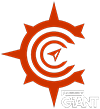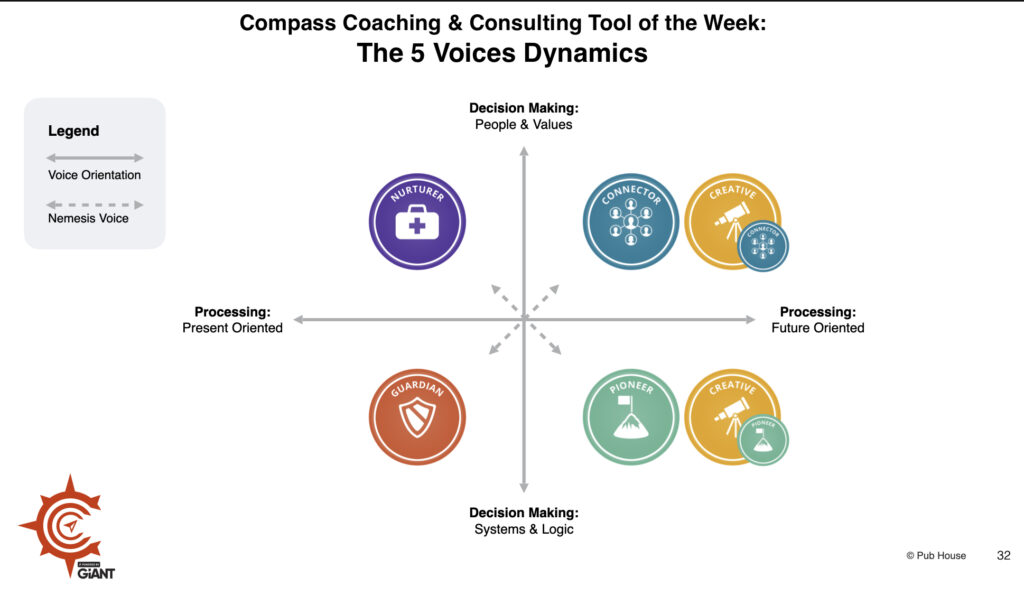The 5 Voices Dynamics tool can be transformative for understanding and influencing others. By grasping the concepts it introduces, one can gain the ability to navigate relationships with individuals who may have perspectives and communication styles which differ from yours.
Each person falls broadly into one of five categories, or “voices,” and by viewing interactions through the lens of this tool, one can better comprehend the motivations and behaviors of others. This understanding can shed light on why certain individuals seem to frustrate us while others seem more naturally aligned with us.
Furthermore, this tool can help us grasp various relational dynamics and appreciate the differing perspectives of others.
The 5 Voices Dynamics are represented by two axes. The vertical line represents one’s inclination in how decisions are made. The top of this line represents voices which weigh “People and Values” heavily in their decision making. The bottom of this line represents voices coming more from a perspective of “Systems and Logic”.
The horizontal line represents one’s inclination for processing information. The left side of this line represents voices which are “Present Oriented” while voices on the right side represent voices which are “Future Oriented”. These axes form four quadrants, each of which represent unique ways for processing information and making decisions.
For example, the top-right quadrant represents decision making centered around people and values with a future-oriented approach to processing. Here you’ll find the Connector and Creative Connector voices.
Connectors and Creative Connectors are enthusiastic about the future and constantly engage in processing and envisioning possibilities. However, they also highly value people and idealistic concepts. On the opposite diagonal quadrant at the bottom left lies the Guardian voice. Guardians are valuable counterparts, although both voices can feel at odds if they fail to appreciate each other’s strengths.
A self-aware Connector will understand their own preference for future-oriented thinking and valuing people and ideals. So when a Guardian enters the picture posing practical questions, the Connector must remember to consider the Guardian’s present-oriented focus. Otherwise, it may seem as though the Guardian is dampening the Connector’s excitement for innovative ideas.
Similarly, Guardians may view Connectors and Creative Connectors as unrealistic dreamers. Both parties can benefit from understanding what it’s like to be in the other’s shoes.
In the bottom-right quadrant, we find the Pioneers and Creative Pioneers. This is where I show up. These voices share the future-oriented processing approach of Connectors but are rooted in systems and logical thinking.
Diagonally across from the Pioneers and Creative Pioneers in the top left quadrant reside the Nurturers, representing 43% of the population. Nurturers prioritize decision making based on people and values and with an orientation towards present moment. Thank God for Nurturers! They are advocates for relationship harmony. If they perceive Pioneers or Creative Pioneers as disregarding others’ ideas or as excessively critical, conflicts may arise. Since Nurturers are inclined to view ideas in how impact the present, they do not tend to see things from visionary mindset towards the future like their nemesis voices, the Pioneer and Creative Pioneer.
Pioneer voices can become frustrated by Nurturers and Guardians, thinking they just don’t “get it” or that they are blind to the opportunities being put in front of them. It can be difficult for Pioneer voices to realize that Nurturers and Guardians are not against them. Guardians are merely trying to surface problems they see in order to avoid creating bigger problems and Nurturers are concerned about how people in the organization will be negatively affected if the initiative is not carried out carefully or communicated well.
If most of a Pioneer’s staff are Nurturers or Guardians, it would be best for the Pioneer to enlist and empower a Nurturer to communicate with the Nurturers and a Guardian to communicate with the Guardians.
Leading is difficult. Sometimes we use broad statements pitting “them against me” when the real issue is simply the dynamics which are created by the interaction of differing voices.
If we know our own voice orientation, if we know ourself well in order to lead ourself well and if we have an understanding of other voices, we can then begin creating a bridge that actually connects to the “other side” in the dialogue.
We can begin to communicate vision and change by understanding what the other person wants and how the other person “sees.”
Ultimately, we’re trying to reach a point of mutual understanding where present oriented voices take their feet off the brake and future oriented voices don’t floor the gas into change and vision. That can only happen when we focus on truly communicating, building relationships of trust and truly coming to value what the other voices contribute to the team. We all have our strengths and weaknesses. These can become complimentary when we can learn and value the differences. Then our individual strengths become effective and our individual weaknesses become irrelevant.

